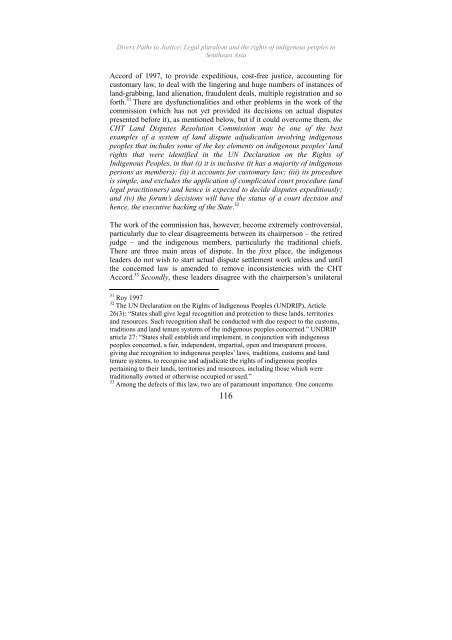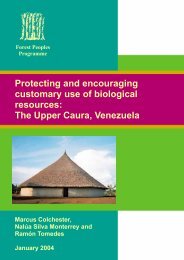Divers Paths to Justice - English - Forest Peoples Programme
Divers Paths to Justice - English - Forest Peoples Programme
Divers Paths to Justice - English - Forest Peoples Programme
You also want an ePaper? Increase the reach of your titles
YUMPU automatically turns print PDFs into web optimized ePapers that Google loves.
<strong>Divers</strong> <strong>Paths</strong> <strong>to</strong> <strong>Justice</strong>: Legal pluralism and the rights of indigenous peoples inSoutheast AsiaAccord of 1997, <strong>to</strong> provide expeditious, cost-free justice, accounting forcus<strong>to</strong>mary law, <strong>to</strong> deal with the lingering and huge numbers of instances ofland-grabbing, land alienation, fraudulent deals, multiple registration and soforth. 31 There are dysfunctionalities and other problems in the work of thecommission (which has not yet provided its decisions on actual disputespresented before it), as mentioned below, but if it could overcome them, theCHT Land Disputes Resolution Commission may be one of the bestexamples of a system of land dispute adjudication involving indigenouspeoples that includes some of the key elements on indigenous peoples’ landrights that were identified in the UN Declaration on the Rights ofIndigenous <strong>Peoples</strong>, in that (i) it is inclusive (it has a majority of indigenouspersons as members); (ii) it accounts for cus<strong>to</strong>mary law; (iii) its procedureis simple, and excludes the application of complicated court procedure (andlegal practitioners) and hence is expected <strong>to</strong> decide disputes expeditiously;and (iv) the forum’s decisions will have the status of a court decision andhence, the executive backing of the State. 32The work of the commission has, however, become extremely controversial,particularly due <strong>to</strong> clear disagreements between its chairperson – the retiredjudge – and the indigenous members, particularly the traditional chiefs.There are three main areas of dispute. In the first place, the indigenousleaders do not wish <strong>to</strong> start actual dispute settlement work unless and untilthe concerned law is amended <strong>to</strong> remove inconsistencies with the CHTAccord. 33 Secondly, these leaders disagree with the chairperson’s unilateral31 Roy 199732 The UN Declaration on the Rights of Indigenous <strong>Peoples</strong> (UNDRIP), Article26(3): “States shall give legal recognition and protection <strong>to</strong> these lands, terri<strong>to</strong>riesand resources. Such recognition shall be conducted with due respect <strong>to</strong> the cus<strong>to</strong>ms,traditions and land tenure systems of the indigenous peoples concerned.” UNDRIParticle 27: “States shall establish and implement, in conjunction with indigenouspeoples concerned, a fair, independent, impartial, open and transparent process,giving due recognition <strong>to</strong> indigenous peoples’ laws, traditions, cus<strong>to</strong>ms and landtenure systems, <strong>to</strong> recognise and adjudicate the rights of indigenous peoplespertaining <strong>to</strong> their lands, terri<strong>to</strong>ries and resources, including those which weretraditionally owned or otherwise occupied or used.”33 Among the defects of this law, two are of paramount importance. One concerns116
















